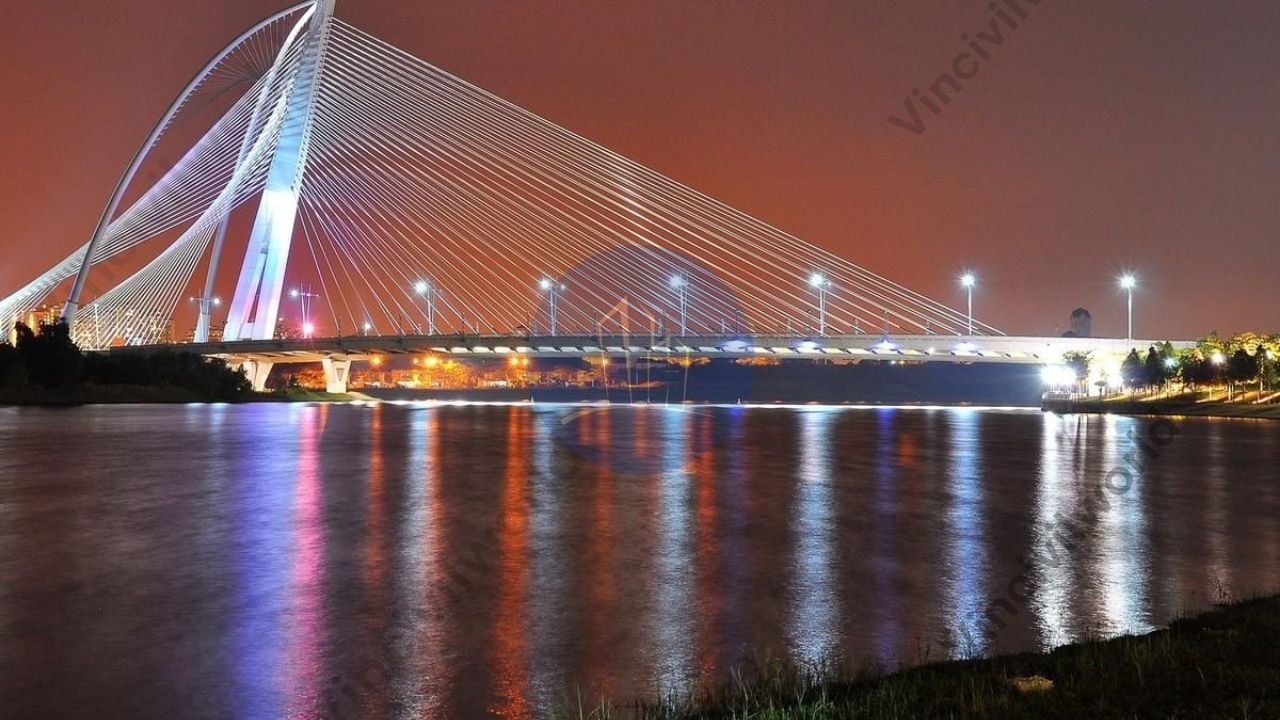Component of a bridge/ bridge components plays a very important role in maintaining the stability and functional requirements of the bridge structure. Each bridge component has its functions. The bridge component types and functions vary as per the site conditions, design requirements, and functional requirements. This article is about a total overview of the components of bridge/bridge components.
A bridge is a structure built over physical obstacles such as water bodies like rivers, lakes, canals, etc, and valleys, roads, etc with minimal obstructing to the area below. During ancient times bridges are made by falling of trees, providing stepping stones, and by tying a rope from the trees. Bridges are the most important components of a highway, railway, and urban roads. Brides play an important role in the socio-economic, politics, culture, defence, etc of a region and a country.
Also read : Components of a road – Elements and their function
Also read : Components of a railway track – Types and functions
Component of a bridge / Bridge components
The components of the bridges are divided broadly into ..

a) Sub- structure
c) Super structure or decking component
Components of a bridge below the bearing constitute substructure and components above the bearings constitute superstructure or decking components.
You tube video – Components of a Bridge
Bridge components – Substructure
The main function of the substructure is to support the superstructure components and transfer the loads to safe strata. The major substructure components of a bridge are as follows.
a) Abutments
b) Wing walls and return walls
c) Piers
d) Pier cap
e) Foundation
Bridge components – Abutments
Abutments functions as vertical supports to the superstructure components at the bridge end. They are the endpoints of a bridge and acts as an approach for the roadway. Abutments retain the roadway backfill and base materials and act as lateral support to the embankments approach. Because of these properties, the abutments are designed as retaining structures.
A single span bridges got two abutments which serves as a vertical support and lateral support. Abutments also resist lateral movement of earth fill of the road approaches.
Abutment are of various types depending on the design requirements and load considerations.
Types of Abutments
- Closed Abutment
- Stub or Perched Abutment
- Pedestal or Spill-through Abutment
- Integral End Bents
- Mechanically Stabilized Abutment
Wing walls and return walls
Wing walls are located near to the abutments as an extension of abutments or as independent structures. They act as a retaining wall to resist the earth in the approach areas. Wing walls may be placed right-angled to the approach way or splayed as shown in the figure.
Piers
Piers are intermediate vertical supports provided between bridge spans. The main function of a pier is to transfer the loads coming on the superstructure to the foundations. Pier got pier caps to provide sufficient bearing areas for the transfer of superstructure loads.
Piers are basically compression members and are designed for vertical loads but in high seismic areas they are designed for lateral loads also.
Foundation
Foundations are constructed to transfer loads coming on the superstructure and substructure to a larger area and hard strata. The foundations may be an open foundation or pile foundation or some other foundation type depends upon nature or soil strata and design considerations. The foundation has to be provided at sufficient depth to ensure protection and chances of failure against the scouring and undermining process.
Also read : Foundation types – Shallow and deep foundations
Also read : Pile foundations – Types and advantages
Component of a bridge – Super structure or decking components
The superstructure constitutes deck slabs, deck beams/girders, trusses, cables, arches, handrails, parapet, etc. The superstructure components depend on the type of bridge-like concrete, composite, steel, etc. The following are the basic superstructure components.
a) Bearings
b) Bridge deck
Bridge bearings
Bridge bearings are components of the bridge that provides a resting surface between the bridge pier and the bridge deck. The main function of the bearing is to control movements and reduces the stresses involved.
A bridge bearing carries the loads or movement in both vertical and horizontal directions from the bridge superstructure and transfers those loads to the bridge pier and abutments. The loads can be live load and dead load in vertical directions, or wind load, earthquake load, etc., in horizontal directions.
Decking components
Decking is the surface over which the traffic like road or rail passes. The decks are supported on beams, girders (prestressed or post-tensioned ) viaducts, prefabricated segments, steel girders or hanged through cables. The whole decking components are supported by pier which transfer the loads to reliable soil strata.
The deck beams shall be conventional rectangular type or of I – GIRDERS (Concrete or steel)
The surface of the deck may be of the concrete or bituminous for movement of traffic.
There are a lot of miscellaneous components like strip seal expansion joints which separates the deck spans, Hand rails are provided on the deck side as a barrier and protection.










8 thoughts on “Component of a bridge|Bridge components-Types, functions”
Comments are closed.